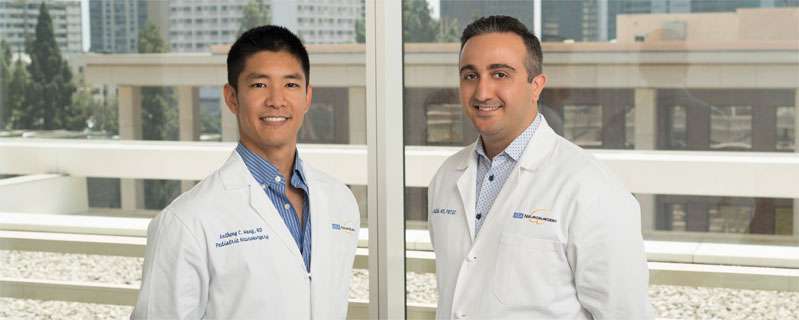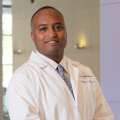Pediatric Chiari and Syringomyelia Program
Find your care
Call 310-825-5111 to learn more about our world-class pediatric neurosurgery services.
Overview of Program
The UCLA Chiari and Syringomyelia Program offers comprehensive diagnostic and state-of-the-art treatment options for patients with Chiari malformation and syringomyelia. Our specialists have evaluated and treated more than 1000 patients over the last two decades.

From left: Dr. Anthony Wang and Dr. Aria Fallah
Watch Webinar: Chiari Malformations in Children
UCLA neurosurgeon Anthony Wang, MD, addresses Chiari malformations, diagnosis and treatment options for pediatric patients.
Diagnostic Services

Clinical evaluation by neurosurgeons with extensive experience in the diagnosis and treatment of Chiari malformation and syringomyelia.
Our program uses a multidisciplinary team approach, with experts in neurosurgery, neurology, and rehabilitation. Advanced magnetic resonance imaging (MRI) is used to evaluate the anatomy and physiology of the base of the skull and the spinal cord. This includes the evaluation of cerebrospinal fluid movement using high-resolution 3 Tesla MRI scanners.
Treatment Services
- Posterior fossa decompression operations are routinely performed at UCLA with excellent outcomes
- Transoral odontoidectomy and fusion is offered for patients with platybasia or basilar invagination
- Neuroendoscopy. We have expertise in the endoscopic management of hydrocephalus or arachnoid cysts causing Chiari malformation.
- Shunt Placement. Our neurosurgery specialists use state-of-the-art techniques and devices, including programmable valves, for the management of syringomyelia cases not treatable by posterior fossa decompression.
Faculty
Pediatric Neurosurgery
Adult Neurosurgery
Resources for Families
- The Chiari & Syringomyelia Foundation, Inc. (CSF)
- American Syringomyelia Alliance Project (ASAP)
- Chiari on EMedicine
Publications
Everson, R, Holly, LT, Batzdorf, U: Chiari I Malformation in the Adult. Neurosurgery Quarterly, Vol. 26 (3), 200-213, 2016
Wang J, Alotaibi NM, Samuel N, Ibrahim GM, Fallah A, Cusimano MD. Acquired Chiari Malformation and Syringomyelia Secondary to Space-Occupying Lesions: A Systematic Review. World Neurosurg. 2016 Nov 25. S1878-8750(16)31228-1
Udani V, Holly LT, Chow D, Batzdorf U: Posterior Fossa Reconstruction Using Titanium Plate for the Treatment of Cerebellar Ptosis After Decompression for Chiari Malformation. World Neurosurg 81 5/6: 836-841, 2014
Batzdorf U, McArthur DL, Bentson JR. Surgical Treatment of Chiari Malformation with and without Syringomyelia. Experience with 177 Adult Patients. J. Neurosurg 118, 232-242, 2013
Than KD, Sharifpour M, Wang AC, Thompson BG, Pandey AS. Chiari I malformation manifesting as bilateral trigeminal neuralgia: case report and review of the literature. J Neurol Neurosurg Psychiatry. 2011 Sep;82(9):1058-9. PMID: 21084262
Witt CE, Wang AC, Maher CO, Than KD, Garton HJ, Muraszko KM. Patient with Chiari malformation Type I presenting with inducible hemifacial weakness. J Neurosurg Pediatrics 8:620-624, 2011. PMID: 22132921
Batzdorf U. Considerations Regarding Decompressive Surgery for Chiari Malformation: World Neurosurg. 75, 222-223, 2011
Wang AC, Than KD, Etame AB, LaMarca F, Park P. Impact of anesthesia on trans-cranial electric motor evoked potential monitoring during spine surgery: a review of the literature. Neurosurg Focus. 2009 Oct;27(4):E7. PMID: 19795956
Boyles AL, Enterline DS, Hammock PH, Siegel DG, Slifer SH, Mehltretter L, Gilbert JR, Hu-Lince D, Stephan D, Batzdorf U, Benzel E, Ellenbogen R, Green BA, Kula R, Menezes A, Mueller D, Oro JJ, Iskandar BJ, George TM, Milhorat TH, Speer MC. Phenotypic definition of Chiari type I malformation coupled with high density SNP genone screen shows significant evidence for linkage to regions on chromosomes 9 and 15. Am J med Genet 140(24):2776-85, 2006
Holly LT, Batzdorf U: Syringomyelia Associated with intradural arachnoid cysts. J Neurosurg Spine 5:111-116, 2006.
Holly LT, Batzdorf U: Management of cerebellar ptosis following craniovertebral decompression for Chiari I malformation. J Neurosurg 94:21-26, 2001
Holly LT, Johnson JP, Masciopinto JE, Batzdorf U: Treatment of posttraumatic syringomyelia with extradural decompressive surgery. Neurosurg Focus 8(3):Article 8, 2000
Batzdorf U: Primary spinal syringomyelia: a personal perspective. Neurosurg Focus 8(3):Article 7, 2000
Pare LS, Batzdorf U: Syringomyelia persistence after Chiari decompression as a result of pseudomeningocele formation: implications for syrinx pathogenesis: report of three cases. Neurosurgery 43(4):945-948, 1998
Batzdorf U, Klekamp J, Johnson JP: A critical appraisal of syrinx cavity shunting procedures. J Neurosurg 89:382-388, 1998
Klekamp J, Batzdorf U, Samii M et al. The surgical treatment of syringomyelia in Chiari I Malformation. Acta Neurochir 138:788-801, 1996.
Klekamp J, Batzdorf U, Samii M: Die Wiederherstellung einer freien Liquorpassage als chirurgisches Behandlungsprinzip der Syringomyelie. Akt Neurologie 23(2):68-74, 1996
Badie B, Mendoza D, Batzdorf U: Posterior fossa volume and response to suboccipital decompression in patients with Chiari I malformation. Neurosurgery 37(2):214-218, August 1995
Halamandaris G, Batzdorf U: Adult Chiari Malformation. Contemporary Neurosurgery, Vol. 11, Lesson No. 26, November 1989
LaHaye P, Batzdorf U: Posttraumatic Syringomyelia. West J Med 148:6:657-663, June 1988
Batzdorf U: Chiari I Malformation with Syringomyelia: Evaluation of Surgical Therapy by MR Imaging. J Neurosurg 68:726-730, May 1988



